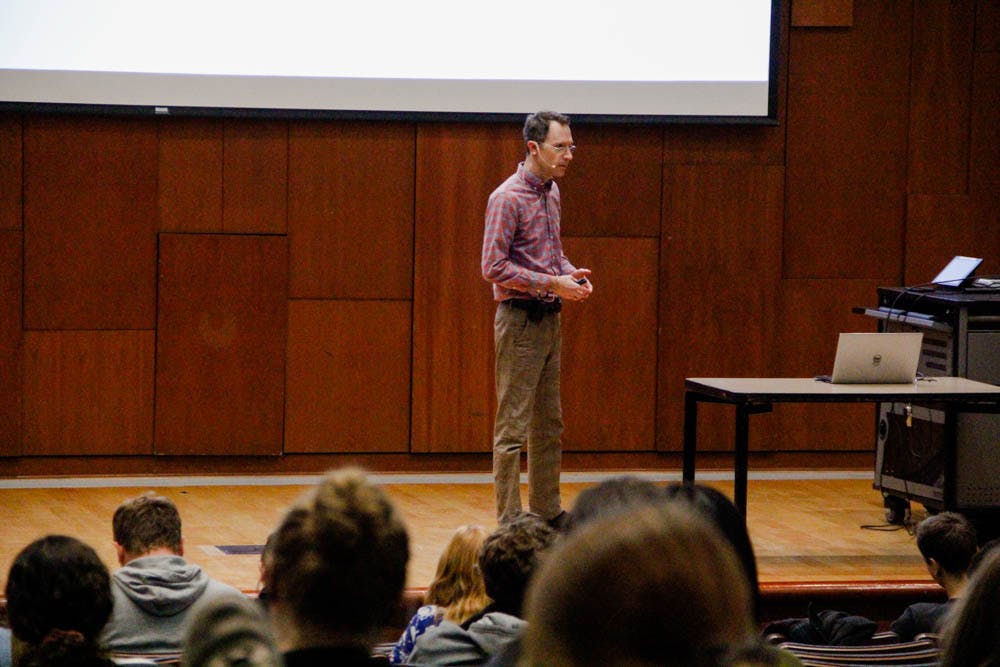James Kellner, assistant professor of environmental studies, holds up a Trilobite fossil, describing the ancient marine creature.
“This animal could see in almost 360 degrees,” he said. Trilobites, which date back more than 520 million years to the Paleozoic Era, are just one of the many ancient beings discussed in Kellner’s popular class BIOL 0210: “Diversity of Life.”
Known as “a must-take class” for both biology concentrators and non-concentrators alike, “Diversity of Life” — an intro course that examines the range of life on Earth and its functions and processes — has attracted more than 300 students this semester. The course is rated above 4.7 out of 5 in the Critical Review, and Kellner has received almost perfect ratings in previous years.
Colin Olson ’23, a non-concentrator currently taking the class, said “I really want to be in (Kellner’s) class again … I think a lot of my positive association with the class comes from him as a person.”
Kellner’s pedagogy is a highlight of the class, said Evan Mizerak '22, one of the course’s undergraduate teaching assistants. “His pedagogical approach to the class … is that the reasoning with which he takes you through all these concepts is such that you can apply it to other STEM classes,” Mizerak said.
Amy Rutter GS, a graduate teaching assistant, added that even though Kellner makes the content highly approachable by giving examples and metaphors, he “does not tone down the science because there’s a wide range of students; he still maintains ... good and cutting-edge, ... in depth science.”
Beyond Kellner’s teaching style, students say the course is successful because it contributes to their understanding of life and their relation to humanity, plants, animals and the environment.
Kellner stressed the importance of understanding biodiversity in a contemporary setting. He remembers being educated to detest invasive species that had been introduced into America, but now he understands that some ‘invasive’ species are beneficial despite originating in other places. At the time, there was no push back against the notion that “invasive species are bad and native species are good” in academia. “For a while I adopted that, but I was never comfortable,” Kellner said, wondering “why should the place of geographic origin determine how I feel about it?”
Achieving biodiversity in ecosystems is complex, and often contested in academia — especially as issues such as species endangerment or conservation are discussed. The promise of biodiversity sometimes comes with a price, and nothing is simply black or white, Kellner said.
After graduating college, he lived this firsthand when he had the opportunity to work on a conservation project in Hawaii. He worked at a captive-breeding program of Achatinellidae, a Hawaiian tree snail found on O’ahu , which is now the subject of a lecture in BIOL 0210.
“The whole lot of work we were doing in Hawaii was funded by the U.S. Army,” Kellner said. The Department of Defense keeps a large part of the federally owned land for conservation, since it is responsible for protecting the endangered species on these lands.
Beyond biodiversity, “Diversity of Life” covers other topics such as sexual selection of birds-of-paradise and human evolution. Students are always very intrigued when Kellner lectures on the complex birds-of-paradise mating dance. They also tend to find lectures on human evolution highly relatable, since it is important to understand humanity’s own history in a grand context, Kellner said.
Outside of his teaching, Kellner conducts laboratory research focusing on the biology of ecosystems using high-resolution remote sensing. The drone remote sensing technology uses LiDAR — Light Detection and Ranging — to measure vegetation or other data across large areas, which provides scientists quantifiable data concerning the change of forests in time and space.
Anna Odell ’20, a lab member focusing on the remote sensing technology, said, remote sensing “allows you to analyze population statistics … you basically have images of the entire world and imagery is becoming more and more accessible. I think it’s absolutely the future of understanding the environment.”
Kellner believes in the optimistic aspect of biodiversity. “There’s all kinds of stuff that has happened, and life persisted all the way through … there’s this transcendent element … and that is the diversity of life.”





